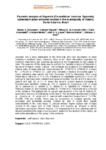Por favor, use este identificador para citar o enlazar este ítem:
http://www.alice.cnptia.embrapa.br/alice/handle/doc/1000415Registro completo de metadatos
| Campo DC | Valor | Lengua/Idioma |
|---|---|---|
| dc.contributor.author | SCHNEIDER, N. A. | pt_BR |
| dc.contributor.author | VIGNATTI, G. | pt_BR |
| dc.contributor.author | AZEVEDO FILHO, W. S. de | pt_BR |
| dc.contributor.author | GIACOMELLI, F. | pt_BR |
| dc.contributor.author | MULLER, C. | pt_BR |
| dc.contributor.author | LOPES, J. R. S. | pt_BR |
| dc.contributor.author | BOTTON, M. | pt_BR |
| dc.contributor.author | ARIOLI, C. J. | pt_BR |
| dc.date.accessioned | 2014-11-18T11:11:11Z | pt_BR |
| dc.date.available | 2014-11-18T11:11:11Z | pt_BR |
| dc.date.created | 2014-11-18 | pt_BR |
| dc.date.issued | 2014 | pt_BR |
| dc.identifier.citation | In: CONGRESSO BRASILEIRO DE ENTOMOLOGIA, 25., 2014, Goiânia, GO. Resumos... Goiânia: Embrapa Arroz e Feijão; Universidade Federal de Goiás, 2014. | pt_BR |
| dc.identifier.uri | http://www.alice.cnptia.embrapa.br/alice/handle/doc/1000415 | pt_BR |
| dc.description | Gyponini has a wide distribution in the Americas and high abundance in plum orchards in southern Brazil. However, there is not much information regarding the economic importance and potential as vectors of microorganisms for the culture of plum. The purpose of this study was to perform the faunistic analysis of Gyponini in two plum orchards, variety ?Letícia?. The orchards are located in the municipality of Videira, state of Santa Catarina, Brazil (orchard #1 - 27º03?18??S; 51º08?46??O, orchard #2 - 27º02?05??S; 51º08?57??O). Each area contains 1 hectare and plants aged 10 years. Sampling was carried out from December 2010 to December 2012 using yellow sticky cards (8.5 x 11.5 cm), installed in 10 equidistant points (35 x 35 m). At each point, two traps were installed and replaced monthly; low (B) at 0.5 m above the ground and high (A) at 1.7 m above the ground. Eleven species belonging to Gyponini were identified: Curtara sp. (13), C. samera (3), Gypona sp. (14), G. acuta (9), G. parvula (5), G. sellata (2), G. stalina (1), G. validana (1), Polana sp. (3), Reticana lineata (1) and Sordana sordida (1). A total of 53 individuals were collected in the orchards. The highest rate of capture has occurred in the trap B, totaling 31 specimens, and only 22 individuals on the trap A. The dominant species were Curtara sp., Gypona sp., G. acuta and G. parvula with respective frequencies of 24.53%, 26.43%, 17% and 9.43%. There was no occurrence of constant species, only accessory and accidental species. Curtara sp. and G. acuta were caught predominantly in the lower traps. G. parvula showed higher capture rate in traps located in the upper part of plant canopy and Gypona sp. showed a similar distribution among the different heights. It is emphasized that this collecting method allowed identifying the most active species in relation to the stratum of the culture, as well as the abundance of the group in the orchards. | pt_BR |
| dc.language.iso | eng | eng |
| dc.rights | openAccess | eng |
| dc.subject | Gyponini | pt_BR |
| dc.title | Faunistic analysis of Gyponini (Cicadellidae: Iassinae: Gyponini), collected in plum orchards located in the municipality of Videira, Santa Catarina, Brazil. | pt_BR |
| dc.type | Resumo em anais e proceedings | pt_BR |
| dc.date.updated | 2015-07-02T11:11:11Z | pt_BR |
| dc.subject.thesagro | Fruticultura | pt_BR |
| dc.subject.thesagro | Ameixa | pt_BR |
| dc.subject.thesagro | Inseto | pt_BR |
| dc.subject.thesagro | Pomar | pt_BR |
| dc.subject.nalthesaurus | Cicadellidae | pt_BR |
| riaa.ainfo.id | 1000415 | pt_BR |
| riaa.ainfo.lastupdate | 2015-07-02 | pt_BR |
| dc.contributor.institution | MARCOS BOTTON, CNPUV. | pt_BR |
| Aparece en las colecciones: | Resumo em anais de congresso (CNPUV)  | |
Ficheros en este ítem:
| Fichero | Descripción | Tamaño | Formato | |
|---|---|---|---|---|
| resumo0480.pdf | 124,59 kB | Adobe PDF |  Visualizar/Abrir |









